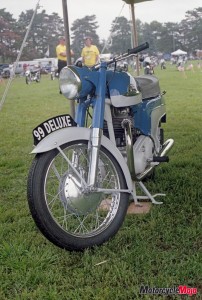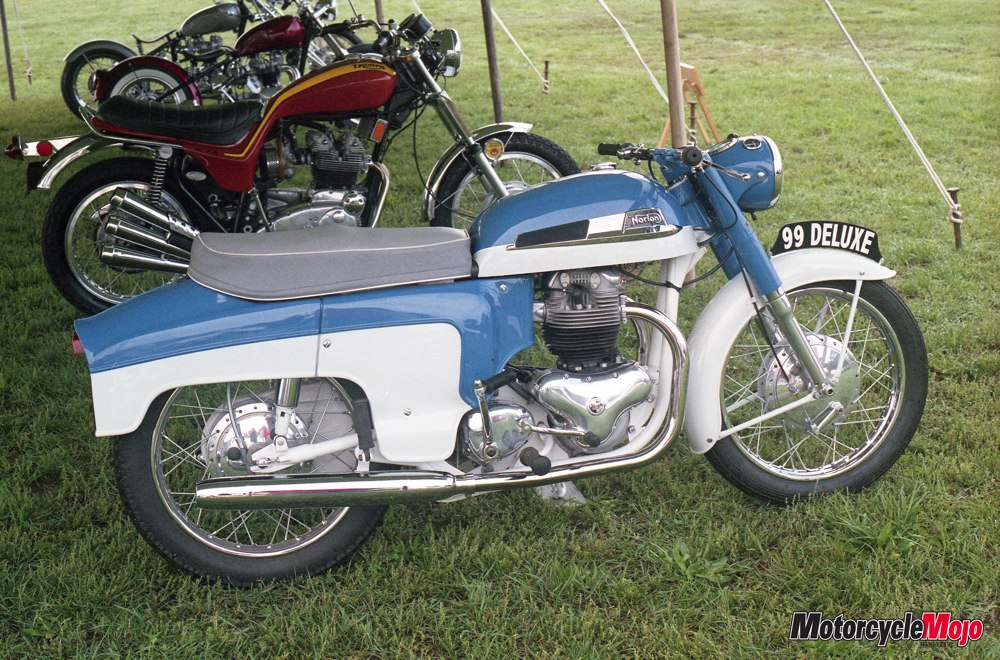More isn’t always better. The weather protection provided by a touring motorcycle is commonplace today, but the introduction of enclosed bodywork in the ’50s was a short-lived experiment that might have been ahead of its time.
Much of what attracts us to one make or model of motorcycle, and not to others, is often the visual appeal of a bike’s general layout and bodywork design. In their day, many bike manufacturers, including Ducati and Bimota, have introduced a few clunkers that didn’t appeal to the buying public. This sometimes happened when a motorcycle builder gave the task of designing the bodywork of a new bike to a car designer. What works with a car, design-wise, doesn’t always appeal to motorcycle riders.
In the 1950s, much of the design work got swept up in a futuristic outlook that affected the appearance of everything from cars to furniture and kitchen appliances. I’m talking about an approach to design that often obsessed on the new jet aircraft, space travel, aerodynamics and a futuristic, new-world look.
 During much of this period, North American cars often featured side mirrors, front grills, air intakes, headlights, rear wings, taillights and other surplus chromed decorative features that had a definite jet or rocket design aspect to them.
During much of this period, North American cars often featured side mirrors, front grills, air intakes, headlights, rear wings, taillights and other surplus chromed decorative features that had a definite jet or rocket design aspect to them.
During this period, a growing number of motorcycle manufacturers began producing new models that featured either semi- or fully enclosed bodywork made out of fibreglass, plastic, thin-gauge steel or aluminum. In some instances, these new sanitized designs obscured virtually all view of the engine and most of the key components of the chassis. The Vincent Black Prince and Black Knight were two examples of this, as were the 250 Ariel Sports Arrow, the 350 Ariel Leader and the 175 Aermacchi Chimera (Dream).
Other motorcycle manufacturers, including British firms Triumph, DMW and Norton, built partially enclosed bodywork designs that left the engine visible, but covered up many other parts of the motorcycle. It was claimed that such designs gave motorcycles a cleaner and more streamlined appearance. Enclosed bodywork was also credited with insulating electrics, carburetion and other key elements from the hazards caused by exposure to rain, dirt and dust.
Norton offered its first semi-enclosed bodywork model in 1958 with the introduction of the 250 Jubilee Deluxe, a 4-stroke pushrod twin that had a fully enclosed rear body section. Within a couple of years, Norton was also offering its semi-enclosed bodywork for the 350 Navigator, the 400 Electra, and the 500 and 600 cc Dominator twins (Model 88 and Model 99 respectively).
The original Dominator twin had been designed by the legendary Bert Hopwood in 1947 to meet the company’s need to offer a modern pushrod twin in order to keep pace with fellow British manufacturers. Hopwood subsequently left Norton, but returned to the firm in 1955 and immediately began upgrading his dated 500 twin with an alloy cylinder head, better electrics and other improvements.
The following year, Norton introduced Hopwood’s latest project, the Model 99 Dominator. This bike was powered by an enlarged and much improved 596 cc twin engine with a higher compression ratio, a hotter Daytona camshaft and an Amal Monoblock carburetor. Hopwood had increased the Model 88 engine displacement by taking its bore from 66 mm to 68 mm, and by increasing its stroke by 9 mm up to 82 mm.
While these changes only boosted peak power by a couple of horsepower to 31 at 6500 rpm, it yielded considerably more pulling power than the
497 cc Model 88. Whereas the 500 Domi was good for 145 km/h (90 mph) in fourth gear, the 596 cc Model 99 was good for 163 km/h (101 mph) and got there considerably faster. Even so, both Norton Dominators were slower on the top end than the 500 and 650 twins of other British manufacturers, including Triumph and BSA.
Although slower, the Norton’s handling was a clear advantage over the competition. Both models employed a wideline version of Norton’s famous featherbed double downtube, full cradle frame, fitted with the company’s Roadholder forks and a twin-shock rear end. The Domis rolled on 19-inch steel rims and were fitted with strong, full-width, aluminum SLS drum brakes – 203 mm up front and 178 mm at the rear. As a result of these combined components, the Nortons could readily run away from their more powerful British competitors on a twisty road.
Norton introduced the Model 99 Deluxe in 1960 as an upmarket touring version of their 600 Dominator. Such a machine, it was argued, would be easier to keep clean thanks to its easily washable rear-enclosing bodywork. The enclosing body panels could be quickly removed for servicing and to provide access to the battery and other items, simply by loosening a few easily accessible bolts.
The Model 99 Deluxe was also better able to keep both the rider and passenger clean once under way, thanks to its fuller touring fenders and enclosed bodywork which protected it from road grime and chain oil.
Model 99 Deluxe owners could also get their machines fitted with a sleek, matching, full touring fairing for added wind and weather protection. Light blue and cream, or letterbox-red and cream were the two colour options available for the 99 Deluxe.
From 1960 onward, the Model 99 was fitted with a slimline featherbed frame, so named because the upper frame rails near the front of the twin saddle had been moved closer together, allowing for a more tucked-in position for the rider.
As it turned out, the 99 Deluxe was introduced just when the café racer craze was kicking into high gear in Britain. Café racers were meant to be lean, spartan and strictly functional. The Model 99, once stripped of its unnecessary extra tinwork, was an ideal candidate for café racer conversion thanks to its featherbed frame and 143.5 cm (56.5 inch) wheelbase, beefy Norton suspension and brakes, and 180 kg (395 lb.) dry weight.
Today, Norton Model 99 Deluxes are rare, since many, if not most, were converted to café racers, and their Clarendon Pressings enclosed bodywork was discarded. Production of the Model 99 was discontinued after 1962 owing to the introduction, that year, of the Norton Dominator 650SS (Special Sport), a larger and much more powerful twin-carb 650 cc version which produced 49 hp and could nudge 193 km/h (120 mph). Now Norton had a Dominator with an engine to match its chassis. Deluxe versions of the 650 SS were made an option for buyers, but didn’t sell well.
By the mid-1960s, Norton, like its close competitor Triumph, called it a day as far as producing enclosed-bodywork motorcycles was concerned. The last big “bathtub,” semi-enclosed bodywork Triumph, a 650 Thunderbird, was discontinued after 1965. Ironically, their new and growing Japanese competition, led by Honda, would continue to produce enclosed-bodywork touring models until the end of the decade, while keeping them distinct from their visually leaner and more functional sporting models. “
















